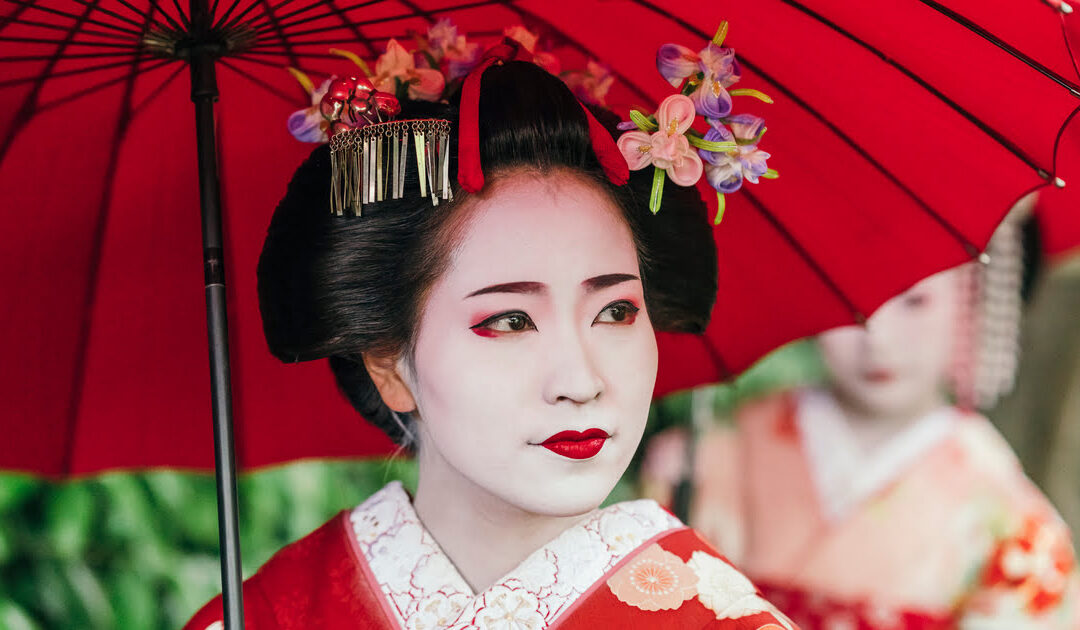When we hear the word geisha, images of women in kimonos, white faces, red lips and delicate movements come to mind. But what is a geisha really? What is its role in the culture of Japan?
Geisha have for centuries been symbols of elegance, art, and tradition, but they have also been surrounded by myths and misunderstandings. In this article we are going to discover their true essence: what it means to be a geisha, how they are formed, what their social role is and how they survive today.
History and evolution of geisha
Origins in the Edo Era
The origin of geisha dates back to the Edo period (1603-1868), in entertainment districts called hanamachi. Interestingly, the first geisha were men who animated gatherings with music and poetry. Over time, women stood out more in this role and became the true protagonists.
Transformations over time
For centuries, geisha were central figures in art, music, and dance. After World War II, their numbers declined dramatically, but they remained guardians of traditions such as the Japanese tea ceremony and the use of instruments such as the shamisen. Today they survive in traditional districts such as Gion, in Kyoto, where maikos and geikos can still be seen walking along cobblestone streets illuminated by lanterns.
Training and training of a geisha
Entrance to the okiya (geisha house)
A geisha’s path begins at the okiya (geisha house), where young women enter as apprentices. There they receive housing, education and clothing, in exchange for years of dedication.
Traditional Arts Learning Process
Future geisha study disciplines such as:
- Traditional Japanese dance (nihon buyo)
- Music with shamisen and taiko drum
- Tea Ceremony
- Poetry, calligraphy and singing
- Art of Conversation and Hospitality in Teahouses (ochaya)
Initiation ceremonies: erikae and mizuage
An apprentice geisha is called a maiko. When she completes her training and becomes a full geisha, she performs the erikae (“neck change”), a ceremony in which she changes the style of her kimono and hairstyle.
The term mizuage, which in the past referred to a rite of passage, has been the subject of controversy and misinterpretation. Currently, the important thing is the ceremony of the debut as a professional artist.
Immerse yourself in the elegance of traditional Japan
Learning Japanese is not just memorizing words: it is discovering a world full of art, history and respect for culture.
Types of geisha
Geiko
In Kyoto, geisha are called geiko, a term that highlights their role as “women of art.”
Maiko (apprentices)
Maiko are young apprentices, recognizable by their more colorful kimonos, hairstyles adorned with kanzashi (accessories), and more striking makeup.
Independent Geisha (jimae)
They are those who, once trained, decide to work independently, without depending on an okiya
Geisha in spa towns (onsen geisha)
In hot spring areas (onsen), there were geisha dedicated to cheering up visitors, although they have often been mistakenly confused with other types of entertainment.
Social and Cultural Role of Geisha in Japan
Preservation of traditional Japanese arts
Geisha are guardians of cultural heritage: they keep alive dances, music, and rituals that would otherwise be lost.
Role in Social Events and Entertainment
Their main role is to liven up meetings in teahouses with music, dance and elegant conversation. They are not mass artists, but elite hostesses.
Bridge between tradition and modernity
Today, many geisha participate in public festivals in cities such as Kyoto or Tokyo, allowing tourists and locals to get up close and personal with this legacy.
Geisha Dress and Appearance
Kimonos: elegance and sophistication on different occasions
A geisha’s kimono is a work of art in itself, accompanied by an elaborate obi (sash) and different accessories depending on the season or event.
Traditional makeup: oshiroi and red lips
The white face with oshiroi, the eyebrows and eyes outlined in black and red, and the lips painted partially or totally depending on the rank, are part of a visual code full of meaning.
Distinctive hairstyles and accessories
The hairstyle varies according to the stage of training. Maiko wear elaborate hairstyles with flower and kanzashi ornaments, while geiko prefer more sober styles and traditional wigs.
Geisha presence in popular culture
Representations in literature and cinema
From novels such as Memoirs of a Geisha (inspired in part by the life of Mineko Iwasaki) to films and documentaries, geisha have fascinated the entire world.
Influence on fashion and contemporary art
The kimono, makeup, and geisha accessories have inspired designers in Japan, the United States, and Europe, leaving their mark on fashion and art.
Cultural tourism and its impact
Today, thousands of tourists visit Gion in Kyoto in hopes of seeing a maiko walking. This has generated debates about the balance between tradition and tourism.
Co-founder and CEO of Doki Doki Japan. After studying Japanese in Japan between 2017 and 2019, he founded this school with the aim of offering accessible and authentic education to students who want to learn Japanese.

